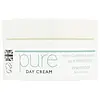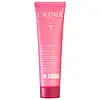What's inside
What's inside
 Key Ingredients
Key Ingredients

 Benefits
Benefits

 Concerns
Concerns

 Ingredients Side-by-side
Ingredients Side-by-side

Water
Skin ConditioningVitis Vinifera Seed Oil
EmollientCetearyl Alcohol
EmollientGlyceryl Stearate Se
EmulsifyingGlycerin
HumectantCaprylic/Capric Triglyceride
MaskingPhenoxyethanol
PreservativeButyrospermum Parkii Butter
Skin ConditioningStearic Acid
CleansingPersea Gratissima Oil
Skin ConditioningSodium Stearoyl Glutamate
CleansingTocopherol
AntioxidantEthylhexylglycerin
Skin ConditioningCarbomer
Emulsion StabilisingXanthan Gum
EmulsifyingCitric Acid
BufferingHelianthus Annuus Seed Oil
EmollientChamomilla Recutita Flower Extract
MaskingAloe Barbadensis Leaf Juice
Skin ConditioningPotassium Sorbate
PreservativeSodium Benzoate
MaskingWater, Vitis Vinifera Seed Oil, Cetearyl Alcohol, Glyceryl Stearate Se, Glycerin, Caprylic/Capric Triglyceride, Phenoxyethanol, Butyrospermum Parkii Butter, Stearic Acid, Persea Gratissima Oil, Sodium Stearoyl Glutamate, Tocopherol, Ethylhexylglycerin, Carbomer, Xanthan Gum, Citric Acid, Helianthus Annuus Seed Oil, Chamomilla Recutita Flower Extract, Aloe Barbadensis Leaf Juice, Potassium Sorbate, Sodium Benzoate
Water
Skin ConditioningVitis Vinifera Fruit Water
Skin ConditioningDicaprylyl Ether
EmollientGlycerin
HumectantButyrospermum Parkii Butter Extract
Skin ConditioningHexyldecanol
EmollientHexyldecyl Laurate
EmollientPalmitoyl Grape Seed Extract
Skin ConditioningBehenyl Alcohol
EmollientGlyceryl Stearate
EmollientAcrylates/C10-30 Alkyl Acrylate Crosspolymer
Emulsion StabilisingErythritol
HumectantLecithin
EmollientMannitol
HumectantTocopherol
AntioxidantCaprylyl Glycol
EmollientHelianthus Annuus Seed Oil
EmollientXanthan Gum
EmulsifyingSodium Benzoate
MaskingVitis Vinifera Juice
AntioxidantGlycine Soja Sterols
EmollientButylene Glycol
HumectantChamomilla Recutita Flower Extract
MaskingSodium Hydroxide
BufferingCitric Acid
BufferingSodium Carboxymethyl Beta-Glucan
CleansingSodium Citrate
BufferingSodium Phytate
Potassium Sorbate
PreservativeBiosaccharide Gum-1
HumectantSodium Hyaluronate
HumectantSodium Levulinate
Skin ConditioningGlyceryl Caprylate
EmollientHomarine Hcl
Skin ConditioningSodium Anisate
AntimicrobialAlcohol
AntimicrobialAcetyl Tetrapeptide-15
Skin ConditioningParfum
MaskingWater, Vitis Vinifera Fruit Water, Dicaprylyl Ether, Glycerin, Butyrospermum Parkii Butter Extract, Hexyldecanol, Hexyldecyl Laurate, Palmitoyl Grape Seed Extract, Behenyl Alcohol, Glyceryl Stearate, Acrylates/C10-30 Alkyl Acrylate Crosspolymer, Erythritol, Lecithin, Mannitol, Tocopherol, Caprylyl Glycol, Helianthus Annuus Seed Oil, Xanthan Gum, Sodium Benzoate, Vitis Vinifera Juice, Glycine Soja Sterols, Butylene Glycol, Chamomilla Recutita Flower Extract, Sodium Hydroxide, Citric Acid, Sodium Carboxymethyl Beta-Glucan, Sodium Citrate, Sodium Phytate, Potassium Sorbate, Biosaccharide Gum-1, Sodium Hyaluronate, Sodium Levulinate, Glyceryl Caprylate, Homarine Hcl, Sodium Anisate, Alcohol, Acetyl Tetrapeptide-15, Parfum
 Reviews
Reviews

Ingredients Explained
These ingredients are found in both products.
Ingredients higher up in an ingredient list are typically present in a larger amount.
Chamomilla Recutita Flower Extract comes from the Chamomile flower.
Chamomile is rich in antioxidants and has anti-inflammatory properties. Several compounds found in chamomile help with soothing, such as bisbolol.
Antioxidant components in chamomile make it an effective ingredient to help slow the signs of aging. Antioxidants help fight free-radical molecules, or molecules that may damage your skin.
Essential oils from chamomile have been found to improve wound healing due to its antimicrobial properties.
Ancient Greeks and Egyptians used Chamomile to treat skin redness and dryness. Chamomile has also been used to help treat stomach issues.
Learn more about Chamomilla Recutita Flower ExtractCitric Acid is an alpha hydroxy acid (AHA) naturally found in citrus fruits like oranges, lemons, and limes.
Like other AHAs, citric acid can exfoliate skin by breaking down the bonds that hold dead skin cells together. This helps reveal smoother and brighter skin underneath.
However, this exfoliating effect only happens at high concentrations (20%) which can be hard to find in cosmetic products.
Due to this, citric acid is usually included in small amounts as a pH adjuster. This helps keep products slightly more acidic and compatible with skin's natural pH.
In skincare formulas, citric acid can:
While it can provide some skin benefits, research shows lactic acid and glycolic acid are generally more effective and less irritating exfoliants.
Most citric acid used in skincare today is made by fermenting sugars (usually from molasses). This synthetic version is identical to the natural citrus form but easier to stabilize and use in formulations.
Read more about some other popular AHA's here:
Learn more about Citric AcidGlycerin is already naturally found in your skin. It helps moisturize and protect your skin.
A study from 2016 found glycerin to be more effective as a humectant than AHAs and hyaluronic acid.
As a humectant, it helps the skin stay hydrated by pulling moisture to your skin. The low molecular weight of glycerin allows it to pull moisture into the deeper layers of your skin.
Hydrated skin improves your skin barrier; Your skin barrier helps protect against irritants and bacteria.
Glycerin has also been found to have antimicrobial and antiviral properties. Due to these properties, glycerin is often used in wound and burn treatments.
In cosmetics, glycerin is usually derived from plants such as soybean or palm. However, it can also be sourced from animals, such as tallow or animal fat.
This ingredient is organic, colorless, odorless, and non-toxic.
Glycerin is the name for this ingredient in American English. British English uses Glycerol/Glycerine.
Learn more about GlycerinHelianthus Annuus Seed Oil is the oil derived from the seeds of a Sunflower. Sunflower seed oil is non-fragrant. It is an emollient, meaning it helps to soften the skin.
Sunflower seed oil contains many fatty acids. The fatty acids found in sunflower seeds include (from highest amount to least): linoleic acid, myristic acid, palmitic acid, stearic acid, arachidic acid, oleic acid, and linolenic acid.
These fatty acids help the skin create ceramides. Ceramides play a role in repairing the skin barrier.
Helianthus Annuus Seed Oil helps moisturize the skin. This in turn helps the skin look more rejuvenated and smoother.
Sunflowers are rich in vitamin E.
Historians believe Indigenous cultures of North America domesticated sunflowers before corn. Thus they relied on sunflower oil for a variety of uses. One such use is moisturizing skin and hair.
Sunflower seed oil may not be fungal acne safe. We recommend speaking with a professional if you have any concerns.
Learn more about Helianthus Annuus Seed OilPotassium Sorbate is a preservative used to prevent yeast and mold in products. It is commonly found in both cosmetic and food products.
This ingredient comes from potassium salt derived from sorbic acid. Sorbic acid is a natural antibiotic and effective against fungus.
Both potassium sorbate and sorbic acid can be found in baked goods, cheeses, dried meats, dried fruit, ice cream, pickles, wine, yogurt, and more.
You'll often find this ingredient used with other preservatives.
Learn more about Potassium SorbateSodium Benzoate is a preservative. It's used in both cosmetic and food products to inhibit the growth of mold and bacteria. It is typically produced synthetically.
Both the US FDA and EU Health Committee have approved the use of sodium benzoate. In the US, levels of 0.1% (of the total product) are allowed.
Sodium benzoate works as a preservative by inhibiting the growth of bacteria inside of cells. It prevents the cell from fermenting a type of sugar using an enzyme called phosphofructokinase.
It is the salt of benzoic acid. Foods containing sodium benzoate include soda, salad dressings, condiments, fruit juices, wines, and snack foods.
Studies for using ascorbic acid and sodium benzoate in cosmetics are lacking, especially in skincare routines with multiple steps.
We always recommend speaking with a professional, such as a dermatologist, if you have any concerns.
Learn more about Sodium BenzoateTocopherol (also known as Vitamin E) is a common antioxidant used to help protect the skin from free-radicals and strengthen the skin barrier. It's also fat soluble - this means our skin is great at absorbing it.
Vitamin E also helps keep your natural skin lipids healthy. Your lipid skin barrier naturally consists of lipids, ceramides, and fatty acids. Vitamin E offers extra protection for your skin’s lipid barrier, keeping your skin healthy and nourished.
Another benefit is a bit of UV protection. Vitamin E helps reduce the damage caused by UVB rays. (It should not replace your sunscreen). Combining it with Vitamin C can decrease sunburned cells and hyperpigmentation after UV exposure.
You might have noticed Vitamin E + C often paired together. This is because it is great at stabilizing Vitamin C. Using the two together helps increase the effectiveness of both ingredients.
There are often claims that Vitamin E can reduce/prevent scarring, but these claims haven't been confirmed by scientific research.
Learn more about TocopherolWater. It's the most common cosmetic ingredient of all. You'll usually see it at the top of ingredient lists, meaning that it makes up the largest part of the product.
So why is it so popular? Water most often acts as a solvent - this means that it helps dissolve other ingredients into the formulation.
You'll also recognize water as that liquid we all need to stay alive. If you see this, drink a glass of water. Stay hydrated!
Learn more about WaterXanthan gum is used as a stabilizer and thickener within cosmetic products. It helps give products a sticky, thick feeling - preventing them from being too runny.
On the technical side of things, xanthan gum is a polysaccharide - a combination consisting of multiple sugar molecules bonded together.
Xanthan gum is a pretty common and great ingredient. It is a natural, non-toxic, non-irritating ingredient that is also commonly used in food products.
Learn more about Xanthan Gum